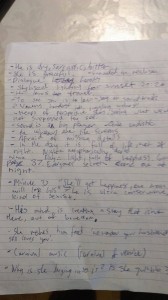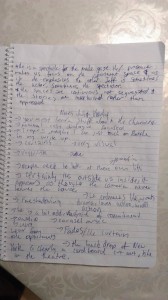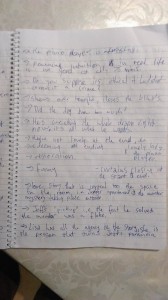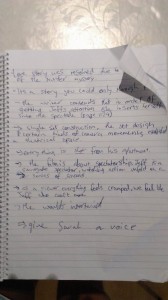This week in Exploding Genre I’ve been watching some films, doing some readings and writing my script and shot list with Dom for our final media piece.
In order to grasp an understanding of Bottle I watched Hitchcock’s Rear Window and read John Beltons ‘The Space of Rear Window’. I found how Belton interpreted space in the film was quite interesting, he contended that when the viewer was looking at the Jeffries story (the part love story part paranoia drama that unfolded in his room) we (the viewer) were the intruders, we were the ones snooping in on a story that we wish we hadn’t had seen (one of paranoia and the discovery of murder). When we were placed in Jeffries room, Jeffries went from the spectator to the spectacle, which I thought was rather interesting-and quite meta. I also found the theatrical elements of the film quite interesting, the way Belton made a link between the fade to blacks in the film and the curtain within the theatre (generally used to mark the end of an act) was quite interesting. This along with Hitchcock’s minimalist set (for Jeffries apartment) and small cast-(there are really only 4-5 characters that get significant screen time) as well the film occurring in entirely one location demonstrate Rear Windows links to theatre.
I’ll have to admit I’m not the biggest fan of action films so I wasn’t super excited for this week, however I enjoyed Ronin far more than a standard action film, possibly because what a ‘standard’ action film is has changed drastically in my teenage years (early 2010s) as opposed to what it was like in the 90s. The reading suggests that in our current day and age narrative is tied up in action, the action is no longer seperate from the narrative. For example in a modern superhero film or a Michael Bay movie, the action and the story are linked (this is because of the films monotonous yet relentless pace), whereas in Ronin and classic Hollywood action films the action punctuates the drama/the story. Bordwell suggests that this change has occurred since cutting has become inexpensive and that speed has become a defining principle of contemporary editing, especially in action movies where there are often lengthy sequences of film where each shot goes for 1-2 seconds. I remember watching Deadpool this year and in the action sequences I counted the time between each shot (because I picked up on the rhythm and new it was going ridiculously quickly) and no shot held for longer than two seconds, most peaked at 2 but some were even quicker. I think some of this is tied up with the role media now plays in peoples lives-its now well established that people have shorter tolerance for lengthier pieces of media (because we are so used to super quick Facebook videos, posts and interactions on our phones) so for any film wanting to appeal to the masses (people that aren’t necessarily fans of cinema) they need to keep shot lengths down just to hold the viewers attention. Lastly, it isn’t just shot lengths that create a quick paced feel in action cinema, it is also other techniques such as: Cutting on bursts of light, Vehicles or other big and quick objects moving quickly in the foreground, jerky camera movements and whiplash pans.
Attached is a copy of the script myself and Dom have been working on in the last week or so.





